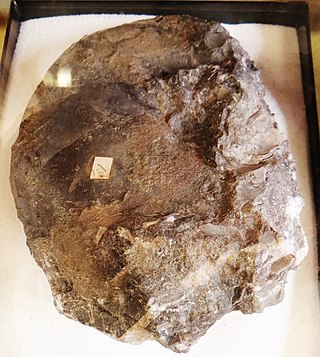
Orthocerida, also known as the Michelinocerida, is an order of extinct orthoceratoid cephalopods that lived from the Early Ordovician possibly to the Late Triassic. A fossil found in the Caucasus suggests they may even have survived until the Early Cretaceous, and the Eocene fossil Antarcticeras is sometimes considered a descendant of the orthocerids although this is disputed. They were most common however from the Ordovician to the Devonian.
Suecoceras is an endoceratid that lived during the Middle Ordovician. It is characterised by a long, straight, slender shell with a slightly expanded tip that curves slightly downwards.

The Tarphycerida were the first of the coiled cephalopods, found in marine sediments from the Lower Ordovician to the Middle Devonian. Some, such as Aphetoceras and Estonioceras, are loosely coiled and gyroconic; others, such as Campbelloceras, Tarphyceras, and Trocholites, are tightly coiled, but evolute with all whorls showing. The body chamber of tarphycerids is typically long and tubular, as much as half the length of the containing whorl in most, greater than in the Silurian Ophidioceratidae. The Tarphycerida evolved from the elongated, compressed, exogastric Bassleroceratidae, probably Bassleroceras, around the end of the Gasconadian through forms like Aphetoceras. Close coiling developed rather quickly, and both gyroconic and evolute forms are found in the early middle Canadian.
Campbelloceras is a tarphyceratid nautiloid known from the Lower Ordovician, Upper Canadian Epoch of North America, where it is widespread. Campbelloceras was named by Ulrich and Foerste in 1936.

Slender Oncoceratidae are those in the family Oncoceratidae, which have slender, commonly curved, shells. Some like Oocerina are gently curved, almost straight, and with only slight expansion. Others like Dunleithoceras are strongly curved with a more notable rate of expansion. Inclusion in this somewhat arbitrary category is based on illustrations in the Treatise Part K, 1964.
The Tarphyceratidae are tightly coiled, evolute Tarphycerida with ventral siphuncles. The dorsum is characteristically impressed where the whorl presses against the venter of the previous. The Tarphyceratidae are derived from Bassleroceras or possibly from some member of the Estonioceratidae.

The Trocholitidae are Tarphycerida with whorls in close contact as with the Tarphyceratidae, but in which the siphuncle, similar in structure, becomes dorsal. The Trocholitidae are derived from the Tarphyceratidae, perhaps from different tarphyceratids.
Bickmorites is an extinct nautiloid cephalopod genus known from the upper Ordovician to the middle Silurian of North America and northern Europe (Norway).
Uranoceras is a barrandeocerid genus from the Middle Silurian belonging to the family Uranoceratidae, characterized by its loosely coiled, gyroconic shell of 1.5 to 2 subquadrate whorls.

Geisonoceratidae is an extinct family of orthoceroid cephalopods endemic to what would be Asia, Europe, and North America from the Middle Ordovician to the Middle Devonian living from about 470—380 mya, existing for approximately 90 million years. With the possible addition of an Early Cretaceous orthocerid from the western Caucasus the range of this group increases dramatically to some 350 million years, thus making it one of the longest lived families of the Nautiloidea.
The Tripteroceratidae is a family of depressed, straight to slightly curved nautiloid cephalopods from the middle and upper Ordovician with generally flattened venters and empty siphuncles with straight to inflated segments included in the Oncocerida.

The Armenoceratidae are a family of early Paleozoic nautiloid cephalopods belonging to the order Actinocerida.
Laureloceras is a genus of the tarphycerid family Plectoceratidae that lived during the Middle Silurian in what is now North America.

The Barrandeoceratidae is a family of coiled nautiloids included in the Tarphycerida that lived from the Middle Ordovician to the Middle Devonian, characterised by mostly compressed shells with a subcentral siphuncle composed of thin-walled segments that may become secondarily ventral.(Flower and Kummel 1950, Sweet 1964).
Augustoceras is a genus of nautiloid cephalopods included in the order Oncocerida and family Valcouroceratidae. It is known form the Middle and Upper Ordovician of Kentucky and Ohio in the US.
Avilionella is a Middle Ordovician tarphyceroid genus consisting of closely coiled, compressed shells with a small perforation in the center, shallow dorsal impression, and subventral tubular siphuncle with thin connecting rings. Chambers are very short, separated by closely spaced, dish-shaped septa. Coiling becomes loose in the mature, adoral, part of the shell.
Chidleyenoceras is a Middle Ordovician tarphyceroid with a closely coiled, evolute shell; whorl section subquadrate, widest just above a broadly rounded venter; dorsum with a broad shallow impression; sutures moderately spaced, weakly sinuous; siphuncle large, subventral, apparently orthochoantitic with tubular segments.
The Apsidoceratidae is a family of Middle and Upper Ordovician Barrandeocerina,, characterized by curved or coiled, smooth, transversely marked, or laterally costate shells, with a conspicuous hyponomic sinus. Early whorl sections tend to be subtriangular; become broader and dorsally impressed in closely coiled forms. Sutures are with lateral lobes in primitive forms but are without lateral lobes, but with ventral lobes in more advanced species with broader sections. Siphuncles are between the center and ventral margin, but not close to either.

Barrandeoceras is a large, coiled, Middle Ordovician nautiloid cephalopod and part of the Tarphycerida. The shell is serpenticonic with whorls touching but not embracing. The adult body chamber becomes freed of the preceding whorl, a rather common character among tarphycerids. Whorl section is oval, somewhat more narrowly rounded ventrally, on the outer rim, than dorsally, on the inner rim. Prominent lateral ribs, at least on inner whorls. Grow lines show a distinct hyponomic sinus. Sutures have lateral lobes. The siphuncle is subcentral.

Domatoceras is a nautiloid genus and member of the Grypoceratidae from the Pennsylvanian and Permian with a wide spread distribution.







